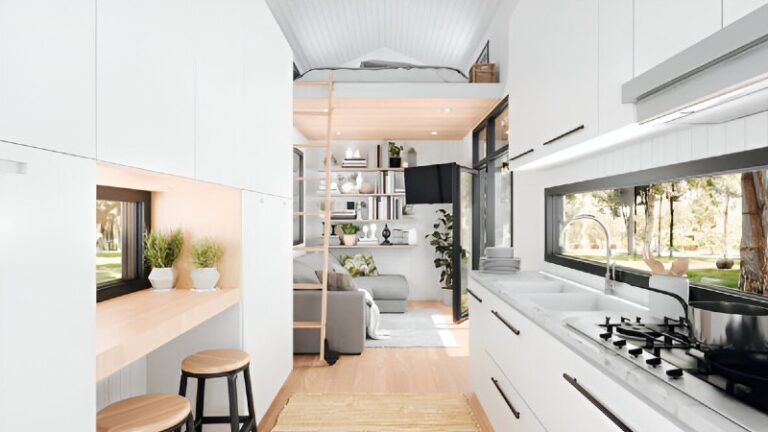In today’s world, where urban living and sustainable lifestyles are on the rise, tiny homes and small apartments are becoming increasingly popular. However, downsizing doesn’t mean compromising on style or comfort. The key lies in smart design, multifunctional furniture, and creative use of space.
Why Tiny Living is More Than Just a Trend
Tiny living is gaining momentum globally for several compelling reasons:
- Financial Freedom: Smaller homes cost less to build, maintain, and heat or cool.
- Environmental Impact: Tiny spaces reduce energy consumption and promote minimalism.
- Urban Accessibility: Compact homes allow residents to live closer to city centers.
According to the Tiny Home Industry Report 2024, the global market for tiny houses is expected to reach $6.5 billion by 2030, demonstrating growing consumer interest in downsized, stylish living.
Core Principles of Maximizing Small Spaces
Efficient small-space design goes beyond furniture selection. It involves a holistic approach, including layout planning, storage solutions, and light optimization.
1. Vertical Space Utilization
Vertical space is often underused in small homes. Incorporating vertical solutions can dramatically increase storage and functionality:
- Lofted Beds: Free up floor space for living areas or workstations.
- Wall-Mounted Shelves: Store books, décor, or kitchen essentials without occupying floors.
- Ceiling Hooks: Hang bikes, plants, or light fixtures.
Example: In a 300 sq ft urban apartment, a lofted bed with a pull-out desk underneath created a separate sleeping and work area without expanding the footprint.
2. Multi-Functional Furniture
Furniture that serves multiple purposes is essential in tiny living. Examples include:
- Sofa Beds: Provide seating by day and sleeping space by night.
- Storage Ottomans: Act as seating, coffee tables, and hidden storage.
- Foldable Dining Tables: Transform into desks or wall-mounted tables.
Table: Multi-functional Furniture Ideas for Small Spaces
| Furniture Type | Primary Function | Secondary Function | Space Saved |
|---|---|---|---|
| Sofa Bed | Seating | Bed | Up to 50 sq ft |
| Storage Ottoman | Seating/Table | Hidden Storage | 5-10 sq ft |
| Foldable Table | Dining/Workspace | Fold-away Storage | 10-15 sq ft |
3. Open Floor Plans and Flexible Layouts
Open layouts enhance the perception of space and increase flexibility:
- Combine living, dining, and kitchen areas to create a seamless flow.
- Use sliding partitions or movable walls to define spaces when needed.
- Integrate pet-friendly zones without disrupting room function.
Example: A 400 sq ft tiny home used a retractable partition to separate a bedroom from the living area during the night, creating privacy while keeping the open floor concept intact.
Lighting and Color Strategies
Proper lighting and color choices can make small spaces feel expansive:
1. Natural Light
Maximizing windows and skylights enhances the visual space:
- Place mirrors opposite windows to reflect light and create the illusion of depth.
- Use sheer curtains to maintain privacy while allowing sunlight to permeate.
2. Color Choices
While neutral tones are classic for small spaces, bold colors and patterns can add personality and dimension:
- Dark accent walls can create cozy focal points.
- Matching wallpaper and upholstery can visually expand walls.
- Bright accents in furniture and décor bring vibrancy without clutter.
Innovative Storage Solutions
Storage is the backbone of functional tiny living:
1. Hidden Storage
- Under-bed drawers for clothing and linens.
- Toe-kick drawers in kitchens for extra pantry items.
- Pull-out cabinets and modular shelving for adaptability.
2. Smart Integration
Integrating storage into structural elements is both practical and stylish:
- Stairs doubling as storage for books, shoes, or kitchenware.
- Built-in benches with liftable tops for seating and hidden storage.
- Wall niches for decorative or functional items.
Outdoor Extensions for Maximum Impact
Outdoor spaces can act as living extensions for tiny homes:
- Decks and Patios: Double as dining or lounge areas.
- Vertical Gardens: Add greenery without taking floor space.
- Retractable Roofs and Sliding Doors: Blend indoor and outdoor areas seamlessly.
Example: A 350 sq ft tiny house in Melbourne featured a foldable deck that transformed the backyard into a dining and socializing area during summer months.
Sustainable and Smart Living
Tiny living naturally aligns with eco-friendly practices, but smart home integration takes it further:
- Solar panels reduce energy consumption and utility costs.
- Tankless water heaters save space and energy.
- Smart thermostats and lighting systems optimize comfort without wasting space or resources.
Case Studies
1. Urban Micro-Apartment, Sydney
- 300 sq ft with lofted bedroom and pull-down desk.
- Open layout combines kitchen, dining, and living areas.
- Hidden storage in stairs and sofa ottomans.
2. Coastal Tiny Home, Byron Bay
- 400 sq ft with retractable deck extending living space outdoors.
- Murphy bed converts the living room into a private sleeping area.
- Solar panels and rainwater collection for sustainable living.
Key Takeaways
- Vertical space and multi-functional furniture are essential.
- Open layouts and proper lighting enhance spatial perception.
- Outdoor extensions expand living areas without increasing the footprint.
- Sustainability and smart technology complement efficient tiny living.
- Intentional design ensures every inch serves a purpose while maintaining style.
Conclusion
Maximizing small spaces without sacrificing style is an art that blends creativity, functionality, and intentional design. From vertical storage and multi-purpose furniture to open layouts and sustainable innovations, tiny living offers a life that is stylish, efficient, and environmentally conscious. By thinking strategically about every inch and embracing innovative solutions, it’s possible to live large in a compact home. Tiny living isn’t just a trend—it’s a lifestyle that empowers comfort, creativity, and sustainability.
Frequently Asked Questions (FAQs)
What is tiny living?
Tiny living is a lifestyle centered around living in small homes or apartments, typically under 500 square feet. It emphasizes simplicity, functionality, and efficient use of space without sacrificing comfort or style.
How can I maximize space in a tiny home?
Maximizing space involves using vertical storage, multi-functional furniture, open floor plans, built-in storage solutions, and outdoor extensions like decks or patios. Proper lighting and thoughtful layout design also make small spaces feel larger.
What are the benefits of living in a tiny house?
Tiny houses offer financial freedom, lower environmental impact, and simplified lifestyles. They also encourage decluttering, reduce energy consumption, and often foster community living through shared resources and tiny house villages.
Is tiny living suitable for families?
Yes. Smart design strategies like lofted bedrooms, fold-down tables, and multi-purpose furniture allow families to enjoy privacy and functionality within small homes. Outdoor areas can also provide additional living space for family activities.
How can I make a tiny home stylish?
Stylish tiny living combines thoughtful color palettes, creative lighting, pattern use, and high-quality multifunctional furniture. Incorporating decorative elements, built-in storage, and open layouts ensures the home feels spacious and visually appealing.
Are tiny homes environmentally friendly?
Absolutely. Tiny homes typically use less energy, require fewer building materials, and can incorporate sustainable solutions like solar panels, tankless water heaters, and composting toilets, significantly reducing their environmental footprint.


